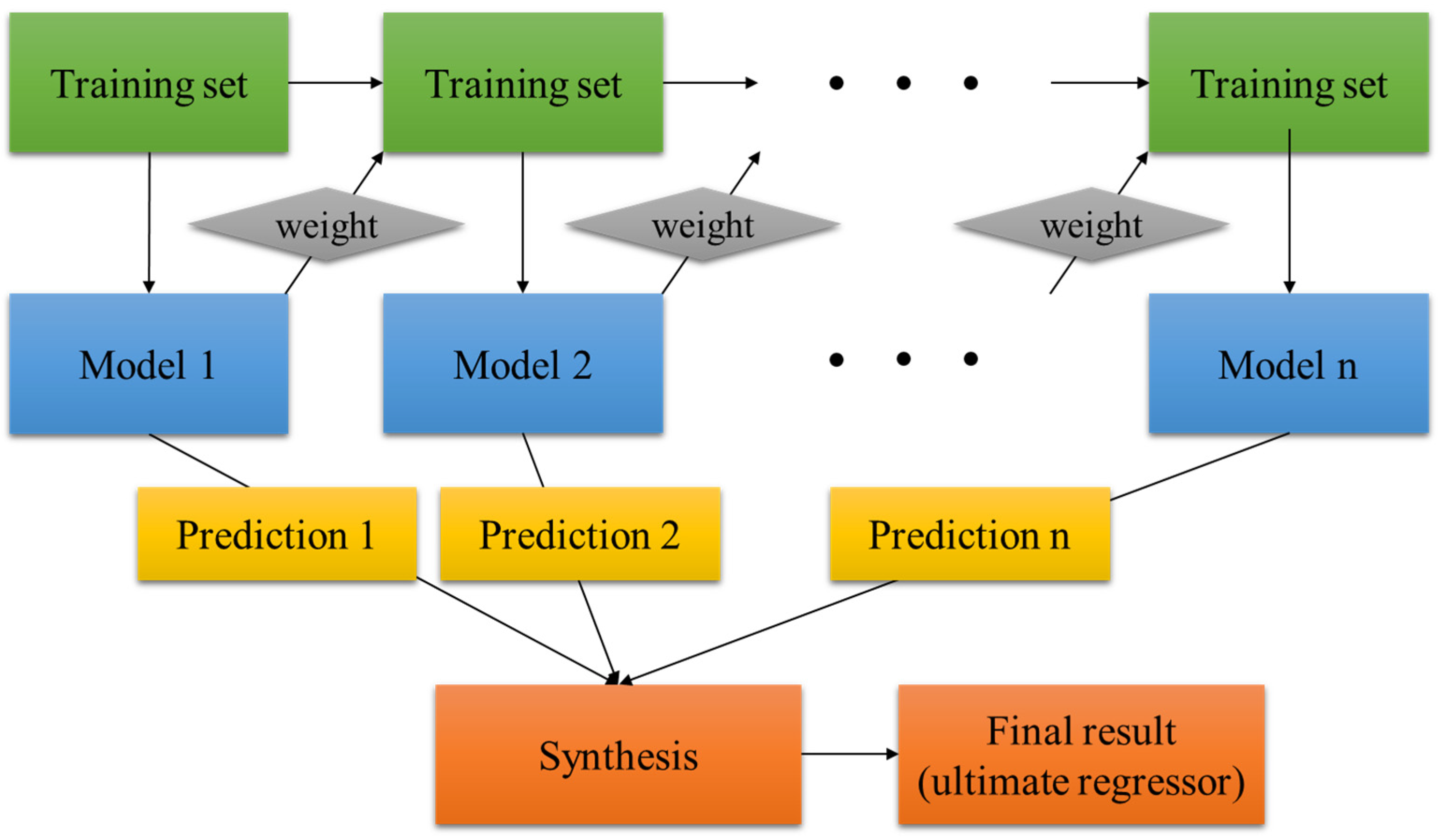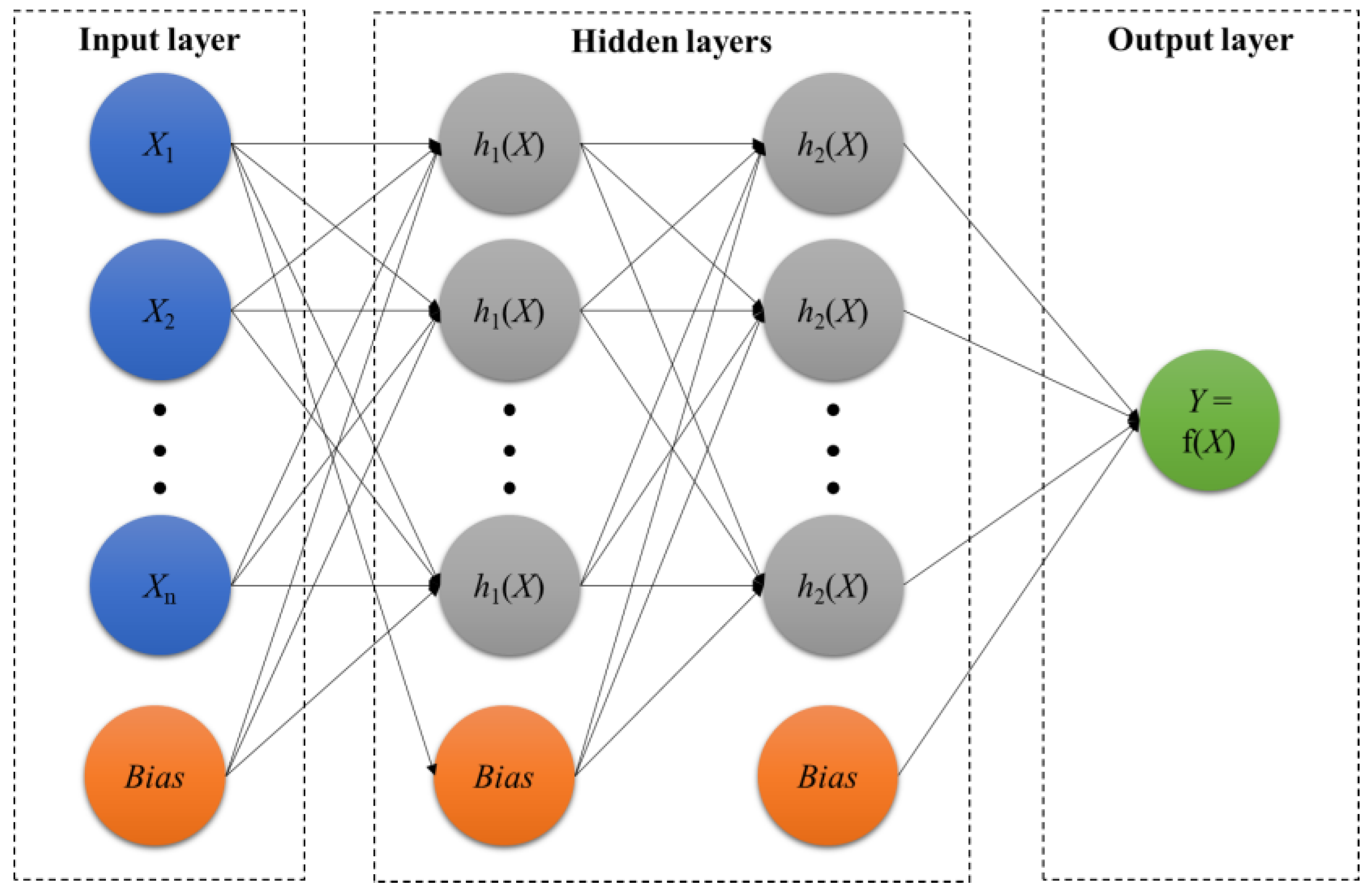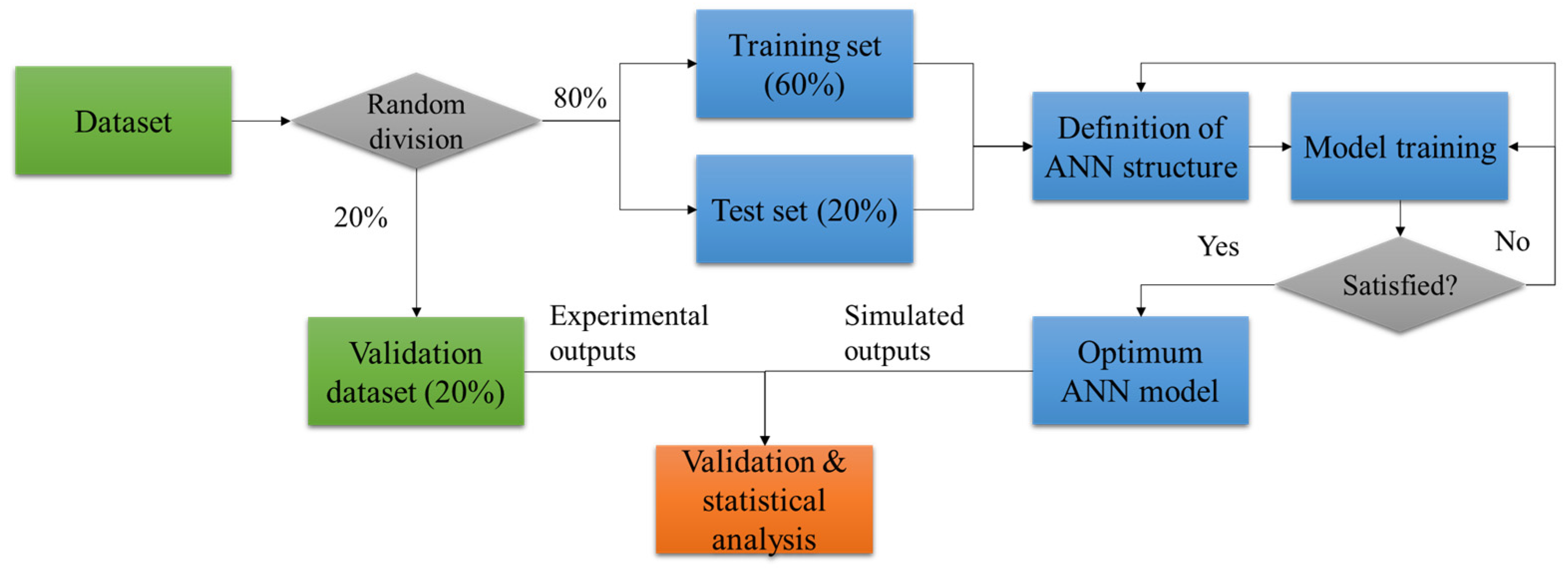Machine Learning Technologies in the Supply Chain Management Research of Biodiesel: A Review
Abstract
:1. Introduction
2. Biodiesel Supply Chain Management
2.1. Biodiesel Production
2.2. Supply Chain Management
3. Machine Learning in Supply Chain Management of Biodiesel
3.1. Machine Learning Algorithms for Feedstock Yield Estimation
3.2. Machine Learning Algorithms for Biodiesel Productivity Prediction
3.3. Machine Learning Algorithms for Biodiesel Quality Prediction
4. Discussion
5. Conclusions and Future Directions
Author Contributions
Funding
Data Availability Statement
Acknowledgments
Conflicts of Interest
References
- Abbaszaadeh, A.; Ghobadian, B.; Omidkhah, M.R.; Najafi, G. Current biodiesel production technologies: A comparative review. Energy Convers. Manag. 2012, 63, 138–148. [Google Scholar] [CrossRef]
- Ma, F.; Hanna, M.A. Biodiesel production: A review. Bioresour. Technol. 1999, 70, 1–15. [Google Scholar] [CrossRef]
- Demirbas, A. Biodiesel; Springer: London, UK, 2008; pp. 111–119. [Google Scholar]
- Yusuf, N.N.A.N.; Kamarudin, S.K.; Yaakub, Z. Overview on the current trends in biodiesel production. Energy Convers. Manag. 2011, 52, 2741–2751. [Google Scholar] [CrossRef]
- Knothe, G. Analyzing biodiesel: Standards and other methods. J. Am. Oil Chem. Soc. 2006, 83, 823–833. [Google Scholar] [CrossRef]
- Illukpitiya, P.; de Koff, J.P. Economics of Small-Scale Biodiesel Production; Tennessee State University: Nashville, TN, USA, 2014; pp. 1–3. [Google Scholar]
- Volta Oil. What Determines Retail Prices for Gasoline and Diesel? Available online: https://voltaoil.com/what-makes-up-retail-price-for-gasoline/ (accessed on 17 October 2023).
- U.S. Department of Energy. Biodiesel Production and Blending Tax Credit. Available online: https://afdc.energy.gov/laws/5831# (accessed on 17 October 2023).
- U.S. Department of Energy. Biodiesel Laws and Incentives in Tennessee. Available online: https://afdc.energy.gov/fuels/laws/BIOD?state=tn (accessed on 17 October 2023).
- Habib, M.S.; Omair, M.; Ramzan, M.B.; Chaudhary, T.N.; Farooq, M.; Sarkar, B. A robust possibilistic flexible programming approach toward a resilient and cost-efficient biodiesel supply chain network. J. Clean. Prod. 2022, 366, 132752. [Google Scholar] [CrossRef]
- Sharma, V.; Vijayaraghavan, T.A.S.; Ram, T.L.R. Resolving operational paradox of sustainable supply chain: A decision framework approach. Socio-Econ. Plan. Sci. 2023, 87, 101565. [Google Scholar] [CrossRef]
- Hiloidhari, M.; Sharno, M.A.; Baruah, D.C.; Bezbaruah, A.N. Green and sustainable biomass supply chain for environmental, social and economic benefits. Biomass Bioenergy 2023, 175, 106893. [Google Scholar] [CrossRef]
- Mridha, B.; Pareek, S.; Goswami, A.; Sarkar, B. Joint effects of production quality improvement of biofuel and carbon emissions towards a smart sustainable supply chain management. J. Clean. Prod. 2023, 386, 135629. [Google Scholar] [CrossRef]
- Karmakar, A.; Karmakar, S.; Mukherjee, S. Properties of various plants and animals feedstocks for biodiesel production. Bioresour. Technol. 2010, 101, 7201–7210. [Google Scholar] [CrossRef]
- Ambat, I.; Srivastava, V.; Sillanpää, M. Recent advancement in biodiesel production methodologies using various feedstock: A review. Renew. Sustain. Energy Rev. 2018, 90, 356–369. [Google Scholar] [CrossRef]
- Bajpai, D.; Tyagi, V.K. Biodiesel: Source, production, composition, properties and its benefits. J. Oleo Sci. 2006, 55, 487–502. [Google Scholar] [CrossRef]
- Ge, J.C.; Yoon, S.K.; Song, J.H. Combustion and emission characteristics of a diesel engine fueled with crude palm oil blends at various idling speeds. Appl. Sci. 2022, 12, 6294. [Google Scholar] [CrossRef]
- Grebemariam, S.; Marchetti, J.M. Biodiesel Production Technologies; Nova Science Publishers, Inc.: Hauppauge, NY, USA, 2017. [Google Scholar]
- Babadi, A.A.; Rahmati, S.; Fakhlaei, R.; Barati, B.; Wang, S.; Doherty, W.; Ostrikov, K.K. Emerging technologies for biodiesel production: Processes, challenges, and opportunities. Biomass Bioenergy 2022, 163, 106521. [Google Scholar] [CrossRef]
- Meher, L.C.; Sagar, D.V.; Naik, S.N. Technical aspects of biodiesel production by transesterification—A review. Renew. Sustain. Energy Rev. 2006, 10, 248–268. [Google Scholar] [CrossRef]
- Leung, D.Y.; Wu, X.; Leung, M.K.H. A review on biodiesel production using catalyzed transesterification. Appl. Energy 2010, 87, 1083–1095. [Google Scholar] [CrossRef]
- Shuit, S.H.; Ong, Y.T.; Lee, K.T.; Subhash, B.; Tan, S.H. Membrane technology as a promising alternative in biodiesel production: A review. Biotechnol. Adv. 2012, 30, 1364–1380. [Google Scholar] [CrossRef] [PubMed]
- Bashir, M.A.; Wu, S.; Zhu, J.; Krosuri, A.; Khan, M.U.; Aka, R.J.N. Recent development of advanced processing technologies for biodiesel production: A critical review. Fuel Process. Technol. 2022, 227, 107120. [Google Scholar] [CrossRef]
- Awudu, I.; Zhang, J. Uncertainties and sustainability concepts in biofuel supply chain management: A review. Renew. Sustain. Energy Rev. 2012, 16, 1359–1368. [Google Scholar] [CrossRef]
- Frazelle, E. Supply Chain Strategy: The Logistics of Supply Chain Management; McGraw-Hill: New York, NY, USA, 2020. [Google Scholar]
- Madenas, N.; Tiwari, A.; Turner, C.J.; Woodward, J. Information flow in supply chain management: A review across the product lifecycle. CIRP J. Manuf. Sci. Technol. 2014, 7, 335–346. [Google Scholar] [CrossRef]
- Papapostolou, C.; Kondili, E.; Kaldellis, J.K. Development and implementation of an optimisation model for biofuels supply chain. Energy 2011, 36, 6019–6026. [Google Scholar] [CrossRef]
- De Jong, S.; Hoefnagels, R.; Wetterlund, E.; Pettersson, K.; Faaij, A.; Junginger, M. Cost optimization of biofuel production—The impact of scale, integration, transport and supply chain configurations. Appl. Energy 2017, 195, 1055–1070. [Google Scholar] [CrossRef]
- Avami, A. A model for biodiesel supply chain: A case study in Iran. Renew. Sustain. Energy Rev. 2012, 16, 4196–4203. [Google Scholar] [CrossRef]
- An, H.; Wilhelm, W.E.; Searcy, S.W. Biofuel and petroleum-based fuel supply chain research: A literature review. Biomass Bioenergy 2011, 35, 3763–3774. [Google Scholar] [CrossRef]
- Kim, S.; Kim, S. Hybrid simulation framework for the production management of an ethanol biorefinery. Renew. Sustain. Energy Rev. 2022, 155, 111911. [Google Scholar] [CrossRef]
- Kasim, F.H.; Harvey, A.P. Influence of various parameters on reactive extraction of Jatropha curcas L. for biodiesel production. Chem. Eng. J. 2011, 171, 1373–1378. [Google Scholar] [CrossRef]
- Ghelichi, Z.; Saidi-Mehrabad, M.; Pishvaee, M.S. A stochastic programming approach toward optimal design and planning of an integrated green biodiesel supply chain network under uncertainty: A case study. Energy 2018, 156, 661–687. [Google Scholar] [CrossRef]
- Mirhashemi, M.S.; Mohseni, S.; Hasanzadeh, M.; Pishvaee, M.S. Moringa oleifera biomass-to-biodiesel supply chain design: An opportunity to combat desertification in Iran. J. Clean. Prod. 2018, 203, 313–327. [Google Scholar] [CrossRef]
- Andersen, F.; Iturmendi, F.; Espinosa, S.; Díaz, M.S. Optimal design and planning of biodiesel supply chain with land competition. Comput. Chem. Eng. 2012, 47, 170–182. [Google Scholar] [CrossRef]
- Abbasi, M.; Pishvaee, M.S.; Mohseni, S. Third-generation biofuel supply chain: A comprehensive review and future research directions. J. Clean. Prod. 2021, 323, 129100. [Google Scholar] [CrossRef]
- Aghbashlo, M.; Peng, W.; Tabatabaei, M.; Kalogirou, S.A.; Soltanian, S.; Hosseinzadeh-Bandbafha, H.; Mahian, O.; Lam, S.S. Machine learning technology in biodiesel research: A review. Prog. Energy Combust. Sci. 2021, 85, 100904. [Google Scholar] [CrossRef]
- Sharma, V.; Tsai, M.L.; Chen, C.W.; Sun, P.P.; Nargotra, P.; Dong, C.D. Advances in machine learning technology for sustainable advanced biofuel production systems in lignocellulosic biorefineries. Sci. Total Environ. 2023, 886, 163972. [Google Scholar] [CrossRef]
- Mahesh, B. Machine learning algorithms-a review. Int. J. Sci. Res. 2020, 9, 381–386. [Google Scholar]
- Wang, Z.; Peng, X.; Xia, A.; Shah, A.A.; Huang, Y.; Zhu, X.; Zhu, X.; Liao, Q. The role of machine learning to boost the bioenergy and biofuels conversion. Bioresour. Technol. 2022, 343, 126099. [Google Scholar] [CrossRef] [PubMed]
- Schulz, E.; Speekenbrink, M.; Krause, A. A tutorial on Gaussian process regression: Modelling, exploring, and exploiting functions. J. Math. Psychol. 2018, 85, 1–16. [Google Scholar] [CrossRef]
- Camps-Valls, G.; Verrelst, J.; Munoz-Mari, J.; Laparra, V.; Mateo-Jimenez, F.; Gomez-Dans, J. A survey on Gaussian processes for earth-observation data analysis: A comprehensive investigation. IEEE Geosci. Remote Sens. Mag. 2016, 4, 58–78. [Google Scholar] [CrossRef]
- Breiman, L. Random forests. Mach. Learn. 2001, 45, 5–32. [Google Scholar] [CrossRef]
- Mabel, M.C.; Fernandez, E. Analysis of wind power generation and prediction using ANN: A case study. Renew. Energy 2008, 33, 986–992. [Google Scholar] [CrossRef]
- Cortes, C.; Vapnik, V. Support-vector networks. Mach. Learn. 1995, 20, 273–297. [Google Scholar] [CrossRef]
- Huang, C.; Davis, L.S.; Townshend, J.R.G. An assessment of support vector machines for land cover classification. Int. J. Remote Sens. 2002, 23, 725–749. [Google Scholar] [CrossRef]
- Thanh Noi, P.; Kappas, M. Comparison of random forest, k-nearest neighbor, and support vector machine classifiers for land cover classification using Sentinel-2 imagery. Sensors 2017, 18, 18. [Google Scholar] [CrossRef]
- Qian, Y.; Zhou, W.; Yan, J.; Li, W.; Han, L. Comparing machine learning classifiers for object-based land cover classification using very high resolution imagery. Remote Sens. 2014, 7, 153–168. [Google Scholar] [CrossRef]
- Rojas, R. AdaBoost and the super bowl of classifiers a tutorial introduction to adaptive boosting. Freie Univ. Berl. Tech. Rep. 2009, 1, 1–6. [Google Scholar]
- Jin, X.; Li, S.; Ye, H.; Wang, J.; Wu, Y.; Zhang, D.; Ma, H.; Sun, F.; Pugazhendhi, A.; Xia, C. Investigation and optimization of biodiesel production based on multiple machine learning technologies. Fuel 2023, 348, 128546. [Google Scholar] [CrossRef]
- Eberly, L.E. Multiple linear regression. In Topics in Biostatistics; Springer: Berlin/Heidelberg, Germany, 2007; pp. 165–187. [Google Scholar]
- Li, Y.; Cao, W. An extended multilayer perceptron model using reduced geometric algebra. IEEE Access 2019, 7, 129815–129823. [Google Scholar] [CrossRef]
- Elgharbawy, A.S.; Sadik, W.A.; Sadek, O.M.; Kasaby, M.A. Glycerolysis treatment to enhance biodiesel production from low-quality feedstocks. Fuel 2021, 284, 118970. [Google Scholar] [CrossRef]
- Kim, S.; Kim, S.; An, K. An integrated multi-modeling framework to estimate potential rice and energy production under an agrivoltaic system. Comput. Electron. Agric. 2023, 213, 108157. [Google Scholar] [CrossRef]
- Yang, P.; Zhao, Q.; Cai, X. Machine learning based estimation of land productivity in the contiguous US using biophysical predictors. Environ. Res. Lett. 2020, 15, 074013. [Google Scholar] [CrossRef]
- Rodriguez-Galiano, V.; Sanchez-Castillo, M.; Chica-Olmo, M.; Chica-Rivas, M.J.O.G.R. Machine learning predictive models for mineral prospectivity: An evaluation of neural networks, random forest, regression trees and support vector machines. Ore Geol. Rev. 2015, 71, 804–818. [Google Scholar] [CrossRef]
- Barbosa dos Santos, V.; Moreno Ferreira dos Santos, A.; da Silva Cabral de Moraes, J.R.; de Oliveira Vieira, I.C.; de Souza Rolim, G. Machine learning algorithms for soybean yield forecasting in the Brazilian Cerrado. J. Sci. Food Agric. 2022, 102, 3665–3672. [Google Scholar] [CrossRef]
- Kim, S.; Kim, S. Performance Estimation Modeling via Machine Learning of an Agrophotovoltaic System in South Korea. Energies 2021, 14, 6724. [Google Scholar] [CrossRef]
- Wang, C.; Xu, S.; Yang, J. Adaboost algorithm in artificial intelligence for optimizing the IRI prediction accuracy of asphalt concrete pavement. Sensors 2021, 21, 5682. [Google Scholar] [CrossRef]
- Gautam, S.; Kanakraj, S.; Henry, A. Computational approach using machine learning modelling for optimization of transesterification process for linseed biodiesel production. AIMS Bioeng. 2022, 9, 319–336. [Google Scholar] [CrossRef]
- Das, P.P.; Rabby, M.M.; Vadlamudi, V.; Raihan, R. Moisture content prediction in polymer composites using machine learning techniques. Polymers 2022, 14, 4403. [Google Scholar] [CrossRef]
- Verduzco, L.F.R. Density and viscosity of biodiesel as a function of temperature: Empirical models. Renew. Sustain. Energy Rev. 2013, 19, 652–665. [Google Scholar] [CrossRef]
- Rocabruno-Valdés, C.I.; Ramírez-Verduzco, L.F.; Hernández, J.A. Artificial neural network models to predict density, dynamic viscosity, and cetane number of biodiesel. Fuel 2015, 147, 9–17. [Google Scholar] [CrossRef]
- Alsugair, A.M.; Al-Gahtani, K.S.; Alsanabani, N.M.; Alabduljabbar, A.A.; Almohsen, A.S. Artificial Neural Network Model to Predict Final Construction Contract Duration. Appl. Sci. 2023, 13, 8078. [Google Scholar] [CrossRef]
- Mairizal, A.Q.; Awad, S.; Priadi, C.R.; Hartono, D.M.; Moersidik, S.S.; Tazerout, M.; Andres, Y. Experimental study on the effects of feedstock on the properties of biodiesel using multiple linear regressions. Renew. Energy 2020, 145, 375–381. [Google Scholar] [CrossRef]
- Kim, S.; Kim, S.; Green, C.H.M.; Jeong, J. Multivariate Polynomial Regression Modeling of Total Dissolved-Solids in Rangeland Stormwater Runoff in the Colorado River Basin. Environ. Model. Softw. 2022, 157, 105523. [Google Scholar] [CrossRef]
- Kim, S.; Kim, Y.; On, Y.; So, J.; Yoon, C.Y.; Kim, S. Hybrid Performance Modeling of an Agrophotovoltaic System in South Korea. Energies 2022, 15, 6512. [Google Scholar] [CrossRef]





| Independent Variables | Nov. | Dec. | Jan. | Feb. | Mar. | Dependent Variable |
|---|---|---|---|---|---|---|
| Temperature (T, °C) | T1 | T2 | T3 | T4 | T5 | Annual average yield data |
| Precipitation (P, mm) | P1 | P2 | P3 | P4 | P5 | |
| Crop evapotranspiration (CET, mm) | CET1 | CET2 | CET3 | CET4 | CET5 | |
| Real crop evapotranspiration (AET, mm) | AET1 | AET2 | AET3 | AET4 | AET5 | |
| Storage (STO, mm) | STO1 | STO2 | STO3 | STO4 | STO5 | |
| Deficit (DEF, mm) | DEF1 | DEF2 | DEF3 | DEF4 | DEF5 | |
| Surplus (EXC, mm) | EXC1 | EXC2 | EXC3 | EXC4 | EXC5 | |
| Phases | Sowing & Vegetative | Flowering | Frutification | Maturation | Harvest |
| Algorithm | RMSE | R2 | ME |
|---|---|---|---|
| RF | 176.93 | 0.81 | 1.99 |
| ANN | 194.22 | 0.77 | −4.3 |
| SVM with radial base function kernel | 213.58 | 0.74 | −15.06 |
| SVM with linear kernel | 203.55 | 0.76 | 4.82 |
| SVM with polynomial kernel | 188.04 | 0.79 | 3.67 |
| Type | No. | Variables | Unit | Description |
|---|---|---|---|---|
| Inputs | 1 | Reaction time (t) | min | Numerical variable, 20–180 min |
| 2 | Reaction temperature (T) | °C | Numerical variable, 30–70 °C | |
| 3 | Catalyst weight (Wc) | wt.% | Numerical variable, 0.4–2% | |
| 4 | Methanol/oil molar ratio (M) | Not applicable | Numerical variable 3–15 | |
| 5 | Feedstock types (F) | Not applicable | Categorical variable, different biomass oil | |
| Outputs | 1 | Biodiesel yield (Y) | % | Numerical variable, 53.12–98.92% |
| k Values | RMSE | Result | |
|---|---|---|---|
| Training | Validation | ||
| 3 | 4.081 | 6.332 | Optimum |
| 4 | 4.567 | 6.444 | |
| 5 | 4.848 | 6.895 | |
| 6 | 5.186 | 7.166 | |
| 8 | 5.399 | 6.805 | |
| 10 | 5.670 | 6.520 | |
| 12 | 5.883 | 6.630 | |
| 16 | 6.101 | 6.969 | |
| 20 | 6.196 | 7.148 | |
| Model | NPLME | WPLME | EPLME | |||
|---|---|---|---|---|---|---|
| R2 | MAPE | R2 | MAPE | R2 | MAPE | |
| LR | 0.7309 | 14.4841 | 0.6824 | 9.8820 | 0.6959 | 9.1998 |
| KNN | 0.8680 | 7.9753 | 0.8217 | 5.5745 | 0.8765 | 4.7121 |
| MLP | 0.8415 | 8.5512 | 0.7761 | 7.9917 | 0.7417 | 7.6580 |
Disclaimer/Publisher’s Note: The statements, opinions and data contained in all publications are solely those of the individual author(s) and contributor(s) and not of MDPI and/or the editor(s). MDPI and/or the editor(s) disclaim responsibility for any injury to people or property resulting from any ideas, methods, instructions or products referred to in the content. |
© 2024 by the authors. Licensee MDPI, Basel, Switzerland. This article is an open access article distributed under the terms and conditions of the Creative Commons Attribution (CC BY) license (https://creativecommons.org/licenses/by/4.0/).
Share and Cite
Kim, S.; Seo, J.; Kim, S. Machine Learning Technologies in the Supply Chain Management Research of Biodiesel: A Review. Energies 2024, 17, 1316. https://doi.org/10.3390/en17061316
Kim S, Seo J, Kim S. Machine Learning Technologies in the Supply Chain Management Research of Biodiesel: A Review. Energies. 2024; 17(6):1316. https://doi.org/10.3390/en17061316
Chicago/Turabian StyleKim, Sojung, Junyoung Seo, and Sumin Kim. 2024. "Machine Learning Technologies in the Supply Chain Management Research of Biodiesel: A Review" Energies 17, no. 6: 1316. https://doi.org/10.3390/en17061316





